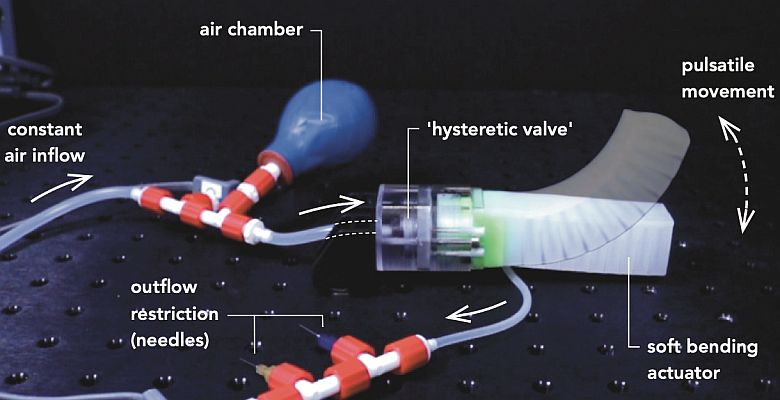The heart of a new soft robot from Technical University Eindhoven is a 'hysteretic valve', as the researchers call their invention.
A cleverly designed pressure valve allows soft robots to react to their environment without computer control. The research by Bas Overvelde (senior lecturer at the faculty of Mechanical Engineering) and Luuk van Laake (PhD student) brings robots that move and feel like living beings closer. Such designs are suitable for exploring rough and unknown terrain or for medical applications.
Soft robotics
Robots are mainly associated with hard machines, controlled by a central computer. Living beings move smoothly because intelligent behaviour is embedded in their bodies. This would also be ideal for robots that constantly interact with people, such as in healthcare. The research field of soft robotics is working on robots made of soft, flexible materials that respond to changes in their environment without external control.
Overvelde, who also works at AMOLF research institute in Amsterdam in addition to his appointment at TU/e, wants to make robots without a central computer that move and react to their environment thanks to built-in reflexes in the robot body. His team developed a soft robot that works on air pressure (without electronics), walks and changes its rhythm by reacting to its surroundings thanks to a cleverly designed valve.
Ketchup bottle
The heart of the new soft robot is a 'hysteretic valve'. It can be recognised as a variation on the opening of a ketchup bottle. The opening makes it easy to dispense ketchup and prevents it from leaking. Nevertheless, ketchup sometimes sputters when it is held upside down and squeezed hard. The opening then rattles open and closed quickly. Modern bottles have been adapted so that they sputter as little as possible. But the Eindhoven researchers wondered whether this normally undesirable behaviour could be used to make a robot move.
In a computer model, they first designed properties such as the stiffness of the minuscule flaps in the valve opening. Then the valves were made by pouring silicone rubber into an accurate 3D-printed mould. With a laser, they cut small notches in it. The result is a valve that is normally closed, suddenly opens when the pressure is high enough, and only closes again when the pressure has dropped significantly. Connected to a pump and reservoir, a rhythm of pressure build-up and air release occurs automatically. In this way, the muscles of the soft robot are alternately inflated and relaxed.
The new component seems simple, but it turned out to have hidden powers. When the researchers made a computer model of two valves connected to the same reservoir, they started moving alternately. Unexpected, but it turned out to work in real life as well. This enabled the researchers to build a four-legged robot with a natural walking rhythm, without external commands. A soft grasping hand with five rhythmically drumming fingers also proved feasible.
Perspectives
Designers dream of soft robots that not only move by themselves, but also react to their environment. Ultimately, they want a robot that automatically changes its walking rhythm when it encounters an obstacle, purely because the muscles and joints respond to the counter-pressure. This is quite successful in the lab. When the researchers briefly close an air hose by squeezing it, the pressure in the robot body changes. The robot then switches to a different walking rhythm. The soft robot can therefore react to its environment without the need for a central computer.
But there is still some way to go before the soft robot is at the care bed. But the prospects are good, the researchers think. Simple components can be used to create complex behaviour without a computer calculating every movement. A soft robot that moves by means of built-in natural reflexes also saves energy.
In living creatures, much movement and behaviour is the result of the construction of the body and the mechanics of the muscles and not on command from the brain. A heart automatically balances the pressure in the left and right ventricles and the elastic energy during walking is stored in tendons with each step. This is very efficient and offers plenty of material for further research.
The scientific publication can be found here.
Photo: video screenshot

